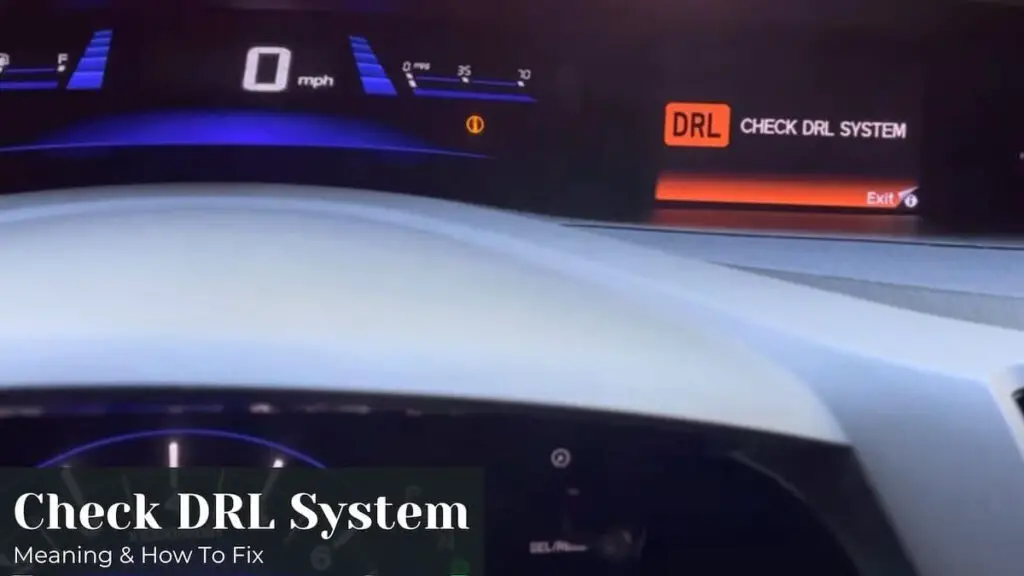‘Check DRL System’, is a warning that appears on the dashboard to indicate a variety of issues with the DRL system.
Possible reasons for this warning include a malfunctioning DRL module, a blown fuse, or a damaged wiring harness.
Let’s dive deeper into the causes of this warning light and how you can turn it off.

1. Failed DRL Module
The DRL module receives input from different sensors and switches including the ambient light sensor, the ignition switch, the headlamp switch, and the parking brake switch. If this module fails or becomes damaged, it’ll cause the check DRL system warning to come on.
2. Blown Fuse
The DRL system usually has a dedicated fuse that protects it from electrical surges. This fuse can be identified from your owner’s manual. If this fuse blows, it’ll result in damage to your DRL system, and cause the check DRL system warning light to show up on your dash.
3. Damaged Wiring Harness
The wiring harness is the network of wires that connects the DRL module to the DRLs. If the wiring becomes damaged, it can disrupt the flow of electricity and cause the DRLs to malfunction.
4. Corrosion or Wear and Tear
Over time, the DRL module and other components of the DRL system may become damaged or worn due to corrosion or wear and tear. This can cause the DRLs to malfunction.
5. Other Electrical Issues
There may be other electrical issues within the vehicle that can cause the DRL system to malfunction. For example, a malfunctioning alternator or battery can disrupt the electrical system and cause the DRLs to stop working.
How to Fix the Check DRL System Warning
1. Inspect The DRLs
Start the car, come out, and inspect the daylight running lights to see if they’re on. If you have any of the lights that don’t come on, that’s the culprit. You’ll need to open the hood and probably take out your car battery to be able to access the light fitting.
2. Check the DRL System Fuse
Get your owner’s manual and check for the location of your DRL system fuse. Once you find the location, you’ll need to use a fuse puller to extract it. You should be looking to make sure that that fuse is not blown.
Hold it up and inspect it to see if the internal fuse connection is still intact. If it is, great. The fuse is not the reason for the warning light. But if it’s not, then you’ll need to buy a new fuse and replace it.
FAQs
How Do I Check the DRL System in My Car?
If your car’s headlights are off and the driver’s side low-beam lights still come on, this could indicate a problem with the daytime running lights (DRL).
To find out if this is the case in your vehicle, turn on the car and shut off its headlights. Then, look at the front of the car to see if its DRLs are illuminated. They should be a low-intensity white or yellow color. If they aren’t illuminated or are the wrong color, consult your owner’s manual or take it to a mechanic for troubleshooting.
How Can I Prevent Problems With the DRL System From Occurring in the Future?
Regularly maintain the system by cleaning and checking for any issues and replacing any components that are damaged or worn.
You should also be mindful of any warning signs that the DRL system may be experiencing problems, such as the DRL warning light coming on or the DRLs not functioning properly.
What Does Check DRL System Mean on Acura MDX?
This means that the system is detecting less electrical resistance than expected with OEM bulbs. You need to add resistors to the DRL line in order to trick the system into believing it’s delivering the correct load or get LEDs with the additional resistors pre-wired.
Conclusion
Daylight Running Lights (DRLs) are an important safety feature that can help improve the visibility and safety of a vehicle on the road.
It’s important to regularly check and maintain the DRL system to ensure that it functions properly and provides the intended benefits.
To diagnose the check DRL system, you can look out for non-illuminated DRLs and diagnose any problems by checking the owner’s manual, consulting a mechanic, or using diagnostic tools.
You can troubleshoot and fix them by replacing components such as fuses or wiring harnesses, or by performing maintenance tasks like cleaning or replacing worn parts.
By following these best practices, you can help ensure that your DRL system is operating at its optimal performance level and keeping you and your vehicle safe on the road.

Ugo is a passionate car enthusiast with a Bachelor of Electrical and Electronics Engineering degree and hands-on experience in troubleshooting and fixing automobiles.
I combine my electrical and mechanical engineering knowledge with practical skills to address car-related issues.
My love for cars and dedication to educating others led to the creation of Fixandtroubleshoot.com!

